The island of Hispaniola is shared by two nations: the Dominican Republic to the east and Haiti to the west. At 10,714 square miles, Haiti is slightly larger than the U.S. state of Massachusetts. While Haiti would be the seventh-smallest state if it were part of the United States, it is the third-largest Caribbean nation by area. It is also the most populous of the Caribbean nations. The island nation is not just the home of over 11.4 million people, though. It is also the native home to many important trees. Let’s look at seven incredible trees that are native to this tropical nation.
1. Royal Palm Tree (Roystonea regia)
The royal palm tree is the national tree of Haiti. (It is also the national tree of Cuba.) The tree appears on Haiti’s flag and coat of arms.
The royal palm was selected to represent the nation because of its strength. On the coat of arms, the liberty cap (a symbol of freedom) is positioned on top of the royal palm tree, representing the strength needed to support the weight of human liberty. The symbolism comes from the tree’s strong timber, often used in construction along with other roles where strength is critical.
The tree also produces hearts of palm, a nutritious food packed with iron, potassium, zinc, and B vitamins. The tree’s roots are used in tifey, a traditional Haitian drink.
The tree can grow 50-80 feet tall in Haiti’s tropical climate.
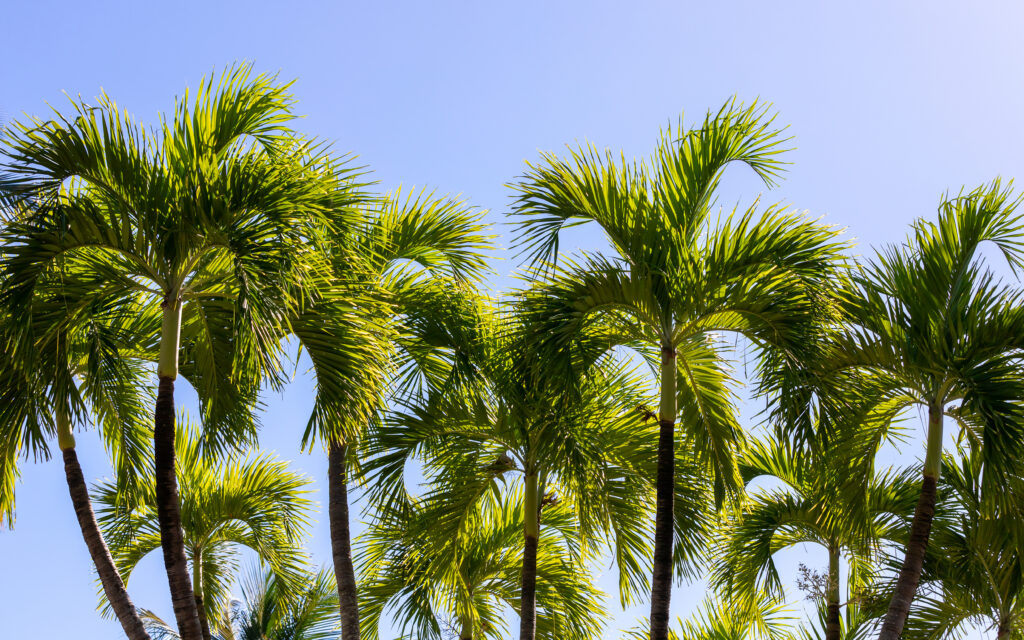
The royal palm is the perfect national tree for a tropical nation like Haiti.
©iStock.com/eugenesergeev
2. Mango Francique Mango Tree (Mangifera indica)
This mango tree is another iconic Haitian symbol. Its fruit is the national fruit of Haiti. The Haitian mango is known as the Madam Francis (or Francique) mango. It is only grown in Haiti. Many mango devotees claim it is the sweetest mango on Earth.
No one is certain of this tree’s origin. Many suspect it is a cultivar of the Bombay mango tree from India. The fruit has a very short growing season of six to eight weeks. The harvest period can be as short as two weeks. That may represent a year’s worth of income potential for the grower.
U.S. Mango Imports
Haiti has been among the top five nations for United States mango imports for many years. However, due to the current political and social unrest in the small nation, the U.S. has suspended the import of Haitian mangoes. The USDA determined it is unsafe for officials from the Animal and Plant Health Inspection Service (APHIS) to be in Haiti, so a temporary ban has been placed on mango imports from the country. Everyone hopes for the day when security is such that APHIS inspectors can return and the much-coveted Haitian mangoes can once again be shipped to the United States.
In the meantime, this tree is and always will be an icon of the embattled nation of Haiti. As one observer wrote in 1931, “The mango tree is probably best known in Haiti. The fruit is highly esteemed, and everywhere along the roads, in the shade of small tents of sacking, we encounter sellers. Old and young, rich and poor, are pleased to taste this delicious tropical fruit that can be consumed without any preparation. The tree is usually large and covers a fairly wide area. Of graceful shape, it is one of the jewels of the flora of Haiti, beautifying the landscape while providing the tired walker or worker the benevolent shadow of its thick foliage.”
3. Coconut Tree (Cocos nucifera)
The coconut tree is the most naturally widespread fruit plant on Earth, and Haiti is one place where this tree proliferates. The pye kokoye (“coconut tree” in Haitian Creole) grows along the coastlines of Haiti.
The coconut tree can grow 90-100 feet tall. The tree’s fruit grows at the very top, which makes the harvest rather difficult. Coconut harvesters in Haiti must scale the tree with a machete. Then, as they hang onto the tree nearly 100 feet in the air, they swing the blade to cut the coconuts from the tree. This is not a task for the faint-hearted!
The coconut tree’s fruit is not a true nut. It is a drupe, similar to a plum, cherry, or almond. The coconut is not only an edible fruit. It is also used in cosmetics and soap. Coconut oil is commonly used in cooking. The sap of the tree can be used in palm wine.
The coconut tree is clearly affixed to Haitian culture. It has found its way into stories and proverbs, such as the Haitian saying, “Hunger makes the dog climb the coconut tree.” Of course, dogs cannot actually climb coconut trees. The point of the proverb is that when you are hungry, you will do anything. Sadly, the truth of that proverb is a daily reality in the troubled nation. Crime and violence often spring up when people are starving.
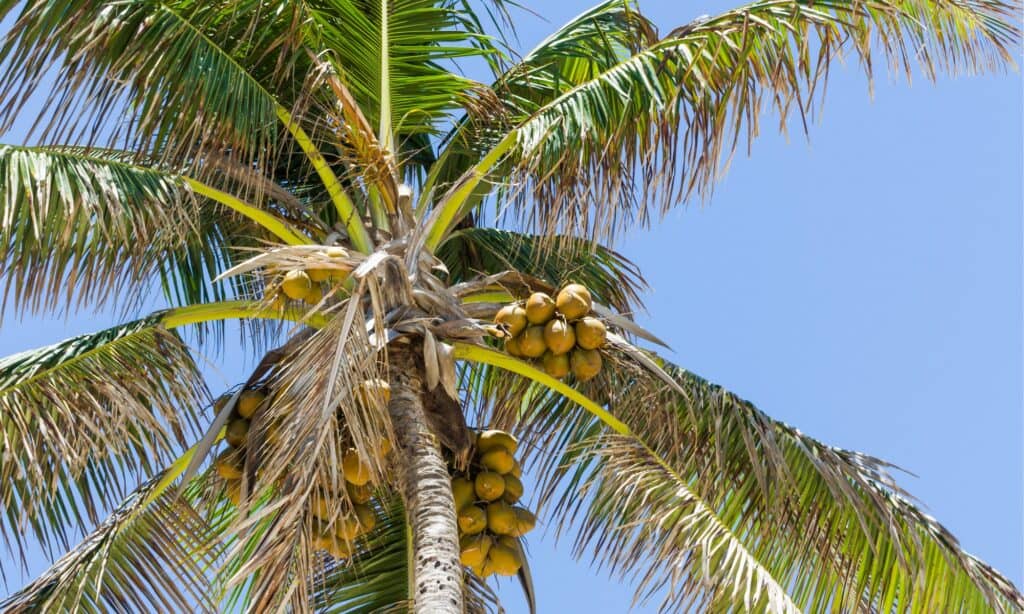
Coconut trees thrive on Haiti’s coast.
©iStock.com/Thiago Santos
4. Ti Koko (Attalea crassispatha)
This rare palm tree is endemic to Haiti. It grows in remote areas of southern Haiti and has been called the rarest palm in the Americas. Less than 30 trees are thought to remain in the wilds of the island nation.
The palm tree grows over 60 feet tall with a large crown of pinnate leaves that can grow over ten feet long. Little is known about the tree due to its remote growing area and its scarcity. Many of these trees have been cut down to make room for farmland or destroyed by fire.
The seeds of the tree are edible, with a flavor similar to a coconut. The nuts are a source of useful cooking oil.
While this palm tree’s fate in its native Haiti is uncertain, Fairchild Tropical Botanic Garden in Florida is working to preserve this rare palm tree.

Fairchild Tropical Botanic Garden in Miami is working to save the rare
Attalea crassispathapalm tree.
©Photo by David J. Stang / CC BY-SA 4.0 – Original / License
5. Northern Haiti Magnolia Tree (Magnolia emarginata)
There are many rare trees in Haiti, but none are rarer than the northern Haiti magnolia tree. The tree had not been seen since 1925 until a conservation team located some individual trees in 2022.
The tree was known to grow in the Morne Columbo forest, but that forest has been decimated. Many feared the northern Haiti magnolia had perished along with that mountain forest.
Discovering the Lost Tree
Since this magnolia grows in high elevations, a team from Haiti National Trust traveled to Massif du Nord, Haiti’s longest mountain range, to search for the tree. After three days of combing through the remote mountain forest, the team spotted an individual tree. After further searching, 16 northern Haiti magnolia trees were found, with even more in juvenile stages.
This tree features lovely white flowers that exude a wonderful fragrance. Eladio Fernández was a member of the team that discovered the trees. The Guardian reported Fernández’s reaction to the aroma of these flowers. He said, “Imagine the privilege of smelling a wonderful perfume that no one else alive on Earth has smelled before.”
Fernández went on to say, “Despite the bleak state of the country’s degraded forests, it still harbors species like this that are found nowhere else in the world, giving us the opportunity to save them.”
6. Hispaniolan Juniper (Juniperus gracilior)
This conifer is a member of the cypress family, Cupressaceae. It is native to Haiti and the Dominican Republic, growing in the mountains of this tropical island. The tree is typically found in high elevations from 3,200-7,300 feet.
This juniper maxes out around 50 feet tall. It is a good source of firewood, so many of these trees have been cut down as a source of cheap fuel. The wood is also useful in making furniture or other projects.
The Hispaniolan juniper is another rare tree in Haiti. Conservationists estimate that less than 1,000 individual trees may still exist.
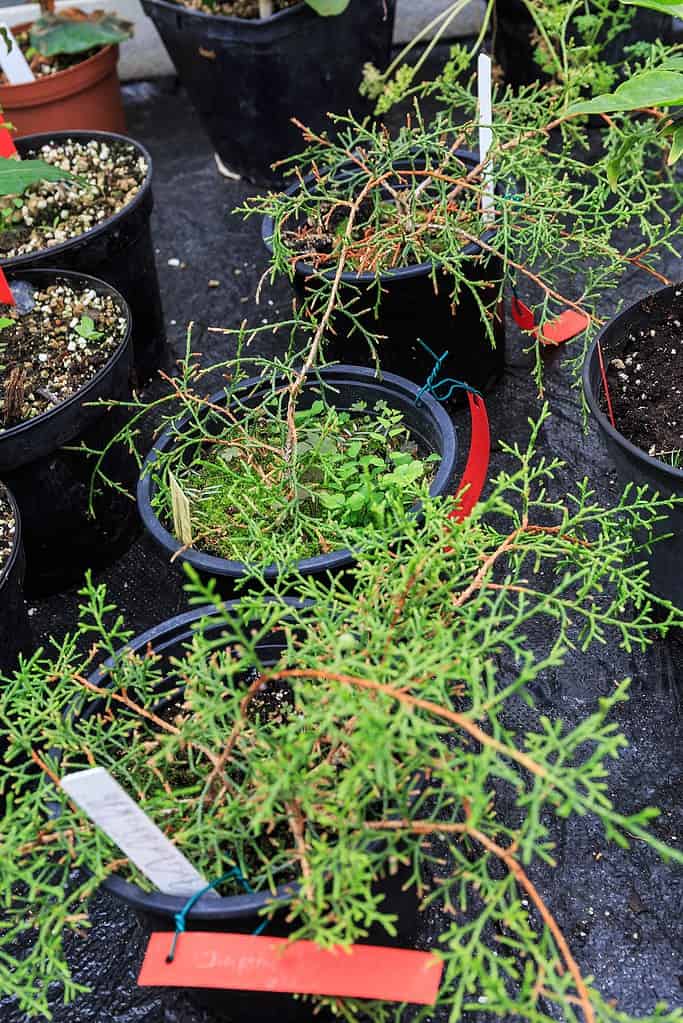
Conservationists are working to save this rare conifer.
©Botanical Conservatory of Brest / CC BY-SA 4.0 – Original / License
7. Manchineel Tree (Hippomane mancinella)
The manchineel tree grows approximately 40 feet tall. It features reddish-gray furrowed bark and glossy, oval-shaped leaves. It is a rather unassuming tree, but that mundane appearance belies the most important truth about this tree: the manchineel tree is widely recognized as the most dangerous tree on Earth.
The manchineel tree produces a milky, thick sap that causes severe blisters on human skin. The sap is so toxic that it can blister skin when diluted in water. Even standing under a manchineel tree in a rainstorm is dangerous, as the raindrops that fall from the tree are laced with this sap.
The tree produces a small fruit that looks and smells like apples, but eating this fruit can be deadly. It is said that when Christopher Columbus’ crew landed in the Virgin Islands in 1493, the famished sailors ate some fruit from a tree on the beach. It was a manchineel tree. Some of the crew died from eating the fruit.
This toxic tree is native to Hispaniola and other Caribbean islands. It also grows in parts of Central and South America. It even grows in remote locations in Florida. Anyone who lives in the manchineel tree’s native tropical region needs to know what it looks like and stay far away from it.
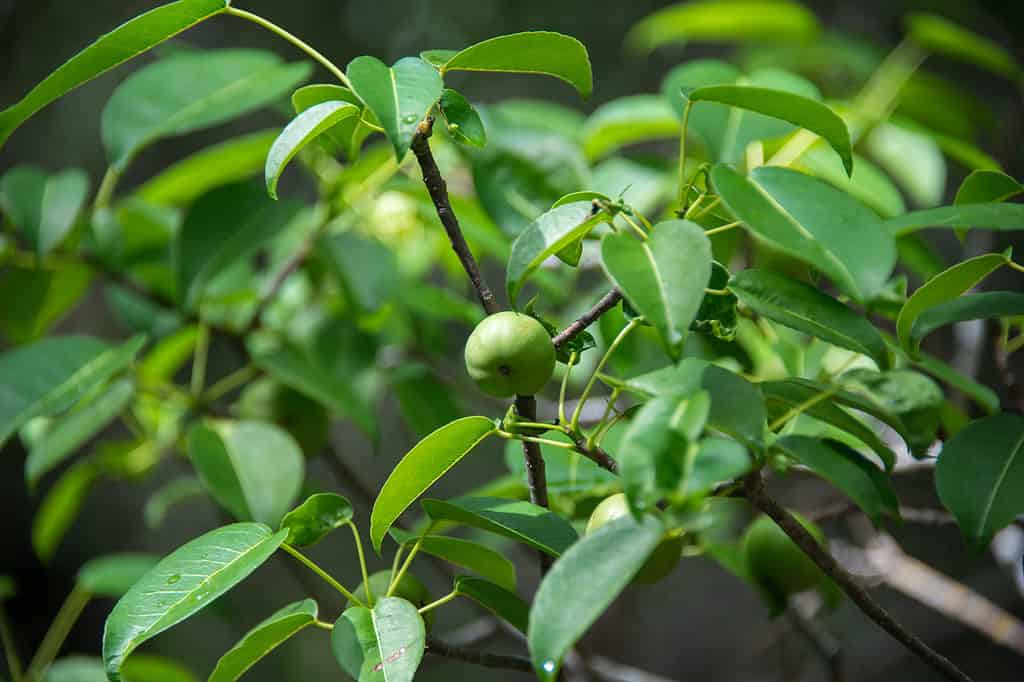
The fruit of the manchineel tree looks and smells like an apple, but DO NOT eat it!
©Karuna Eberl/Shutterstock.com
The Forests of Haiti
Many of Haiti’s trees are in grave danger of disappearing forever. The forests of Haiti have been decimated through unregulated deforestation. Haiti also consistently ranks among the poorest nations on Earth. The forests have been cleared largely for charcoal production. It is an inexpensive and effective fuel source. However, this fuel still comes at a great cost to the nation.
Haiti has gone from thirty percent forested in 1940 to ten percent in 1970 to two percent at the turn of the twenty-first century. By some estimates, the forests of Haiti could be completely gone by 2038. Other estimates paint a slightly less grim picture, but all agree that the forests of Haiti are disappearing rapidly.
Trees are vital to both animal and human survival. They are critical for clean air and water, as well as fertile soil. The disappearance of trees from Haiti has created a desperate situation on the island.
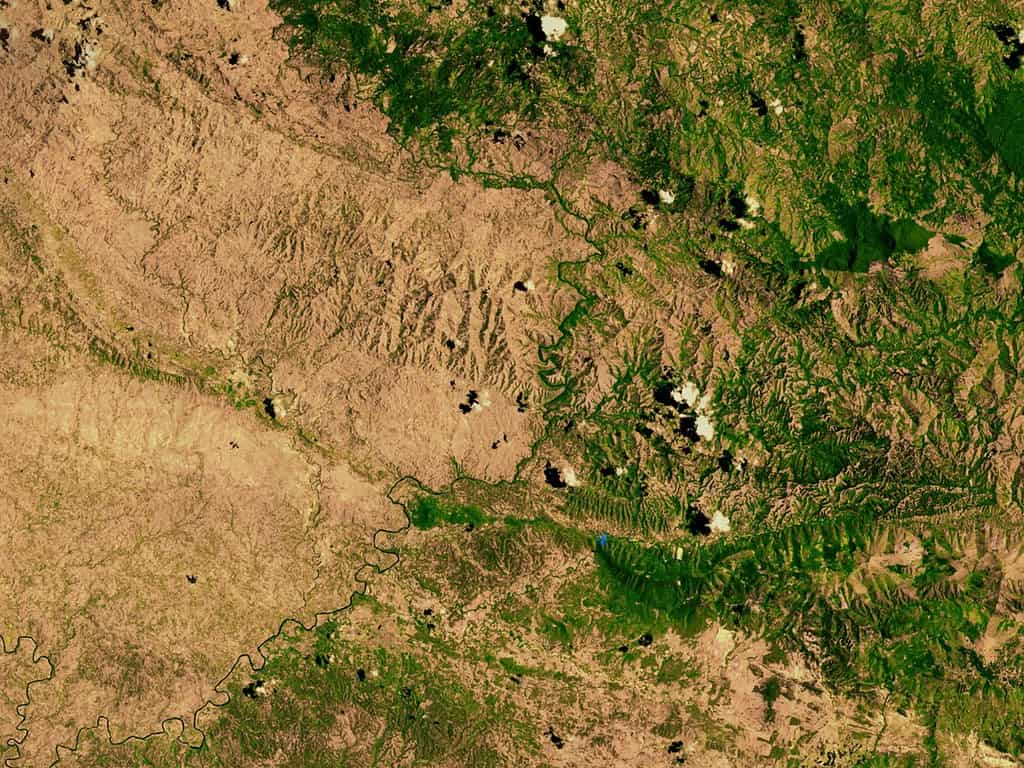
The deforestation of Haiti is so severe that the boundary between Haiti and the Dominican Republic can be seen from space.
The Root Cause of Haiti’s Deforestation: Poverty
This does not mean we should wag our fingers at Haiti, though. One can hardly blame Haitians who live in abject poverty for seeking out the cheapest fuel source possible. After all, it would be quite difficult to care about sustainability for tomorrow when you are not sure if you and your family will eat today.
It is important that we understand the reasons behind the deforestation crisis in Haiti. It is also important to recognize how continuing to strip the land of its trees will make a bad situation even worse.
The lack of forest cover opens the island up to even greater destruction from hurricanes and tropical storms. Removal of trees could also render the soil infertile, which would devastate agriculture on the already starving island. Without trees, more and more precious topsoil is lost to erosion during each monsoon season. The deforestation of this poor island nation has had devastating consequences, and unless things change quickly, it is only going to get worse.
The photo featured at the top of this post is © Studio Barcelona/Shutterstock.com
Thank you for reading! Have some feedback for us? Contact the AZ Animals editorial team.







